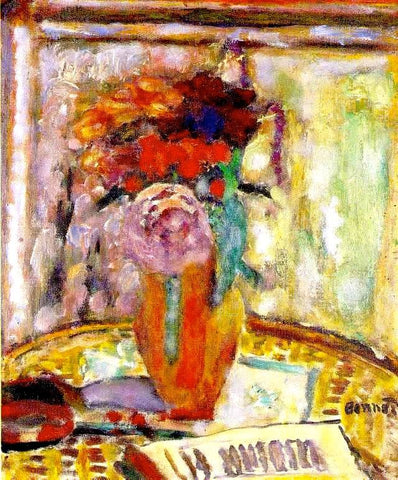.Bonnard - Mentor of Aimé Maeght
 Pierre Bonnard, Summer, 1909, oil on canvas, 260 x340 cm. Maeght Foundation Collection.
Pierre Bonnard, Summer, 1909, oil on canvas, 260 x340 cm. Maeght Foundation Collection.
The first meeting between Aimé Maeght and the master Nabis took place in Cannes in 1936 thanks to a lithograph. Pierre Bonnard, a recognized artist, already elderly – he will be 70 years old – comes to find Aimé Maeght to print the poster for a Maurice Chevalier gala. Aimé, after having been a lithographer worker at the Robaudy printing works in Cannes, opened his own workshop.
The two men immediately liked each other and from then on, it would not be uncommon to come across his tall, slim figure at the Maeghts. He wears a mustache and his gaze, of extreme intensity behind his iron-rimmed glasses, seems to be protected from the outside world. Maybe even from the art world. Does he not claim, moreover, not to belong to any school but simply to do personal work?
“Bonnard was the great turning point in my life, he became, step by step, my great friend,” says Aimé Maeght. And reciprocally, the painter confides: “If I had had a son, that’s how I would have wanted it.”
40 years separate them but a great friendship is formed.
Pierre Bonnard and Aimé Maeght, Midi Beach in Cannes, summer 1946
A decisive episode allows us to better understand the emotional bond uniting the Maeghts to Bonnard.
While Aimé Maeght is still in the Naval Infantry in Toulon, a lady enters the Maeghts' shop, which is ahead of the ARTE printing company created by Aimé Maeght: “I see that you sell paintings,” she says. to Marguerite, “I am a painting dealer” replies the one who only had the sale of a few paintings to her credit. This is how the widow of Henri Lebasque (1865 – 1937) entrusted him with some works. The same day, an elegant gentleman was interested in a painting: “Are you sure it’s not a stolen painting, because it’s so cheap!” » It is Roger Berheim, son of the famous Parisian merchant, the sale is concluded. Faced with this success, Madame Lebasque advised Marguerite Maeght to go see her neighbor, also a painter, who would perhaps be happy to give up some paintings. With her handcart Marguerite Maeght climbs to the top of Cannet. “It seems that you make paintings which are very good, I could sell them easily. » This is how Marguerite Maeght first addresses Pierre Bonnard. The 73-year-old artist finds this young woman sparkling.
Pierre Bonnard, Young girl lying down, 1921, oil on canvas, 56 x61 cm
When he speaks to her, she is only five feet tall, he bends in half! This daily friendship will not be denied.
Pierre Bonnard, Marguerite and Bernard Maeght, 1943, pencil on paper, 21x26 cm.
Aimé Maeght, with his sense of art history, does not fail to capture, camera in hand, these wonderful moments of intimacy with the painter. This is how the only films in the world where we see Pierre Bonnard are those captured by the Maeghts, picnic on the Lérins Islands, swimming in Cannes, stroll in the streets of Suquet.
Upon liberation, Pierre Bonnard and Aimé Maeght went to Paris with the aim of finding and opening a gallery. They shared the same hotel room for more than a month.
“A very curious kind of friendship had formed between Bonnard and me which went beyond the friendship of two men with such a difference in age. For me Bonnard is The Painter. In the long discussions I had with him, it was he who was the basis of my evolution and the opening of my mind to living art. Without Bonnard, I might have continued like the other merchants. » Liked Maeght.
Pierre Bonnard and Aimé Maeght, Cannes, 1943
Pierre Bonnard and Aimé Maeght pedal boating, October 1946

Pierre Bonnard, Landscape of the South and two children, 1916–1918
In his paintings Pierre Bonnard gives objects a human value and reproduces things as the eye sees them. His vision is reminiscent of that of the Primitives. He has no equal when it comes to combining shapes and colors and meeting the demands of emotion. It offers the gaze the feeling of life.

“The Vase of Flowers” by Pierre Bonnard, in 1945.
But the most interesting thing in this painting is the space organized by Bonnard, hop a vertical white line on the left, an arc of a circle (the table) the horizontal lines at the top of the painting... In fact, everything is not that search for balance when no symmetry exists. How to counter perceived evidence. Isn't this a response to impressionism?
blbon blmod




